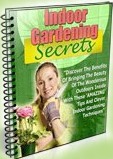Author Archive
 42-Container Vegetable Gardening
42-Container Vegetable Gardening
There are times when planting your own vegetables is almost impossible due to poor climate, inadequate space, or physical obstacles that make it difficult to reach the ground. But if having home grown, healthful vegetables is important to you, the best way to accomplish your goal is to grow your produce using the container vegetable gardening method. Anywhere from a patio or porch to window boxes and doorsteps can be perfect spots for placing containers ready to yield a terrific harvest for you and your family.
The first step in container vegetable gardening is to determine where you want to place your container garden. Try to choose a spot that gets roughly five hours of direct sunlight a day. Also keep in mind any little hands that may want to explore your plants.
The next thing to decide is what types of vegetables you want to grow. That will dictate the container sizes. Anything that will grow in your region in a regular vegetable patch will do just fine using the container vegetable gardening method. A lot of success has been found growing squash, lettuce, and eggplant in containers. Other success stories include beans, onions, and tomatoes. Cucumbers and pole beans can do very well too, just be sure to have the space they need since they are very vine like plants. If you want, many seed catalogs offer mini versions of many of the popular vegetables.
Moving on to containers for your vegetable garden. Many people have discovered that all types of containers work very well for this type of gardening. Some of the more inventive options have been gallon cans, old tubs, and bushel baskets. Of course, the standard plastic or ceramic pots will take care of your container vegetable gardening needs as well. For the smaller vegetables like green onion and herbs, pots that are 6-10 inches will work nicely. For the larger plants, tomatoes and eggplant being part of this group, a pot that is around the size of a 5-gallon bucket is a good choice. Whichever size pot you decide you need and use make sure it has adequate drainage in the bottom.
Now that your plants are planted and sprouting up through the soil be sure to keep a close eye on them. Plants can be the targets of bugs and disease just like in a regular vegetable patch. Container vegetable gardening is easier to check on due its close proximity to the house. If you see any signs of damage from bugs or disease, pick a safe insecticide and fungicide to protect your vegetables from further damage.
Keeping these tips in mind will almost certainly assure you of a bumper crop of your favorite vegetables come harvest time, all without needing a large yard to grow them. Container vegetable gardening makes it all possible.
 Water Gardening
Water Gardening
If there is at least six hours of light on it, and as long as a container can hold enough water to sustain some plants, and perhaps some fish, any container can become the basis for a water garden.
Water gardening used to be limited to ponds and larger bodies of water. Now, many people can enjoy the pleasures of water gardening, even if they live in an apartment. Water gardening has different needs than regular soil gardening, and as long as those needs are maintained, water gardening can be successful in some surprising places.
A container that will hold at least 15
